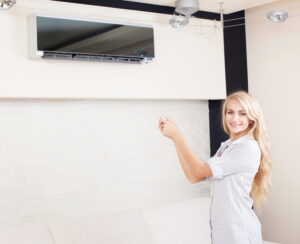
We are going to take a closer look at ductless heating in today’s post—how it is that ductless mini splits work, and what benefits they have to offer. That way, you’ll have a much better idea of whether or not this type of system is appropriate not only for your home, but for your personal heating preferences as well. As always, reach out to our Cherry Hill heating pros with any questions you may have.
Transferring Heat vs. Generating It Anew
There are cooling-only ductless mini splits out there, but the heat pump model is what most homeowners are drawn to. Like other heat pumps, ductless mini splits heat homes not by generating new heat via the combustion of fuel or through electric resistance but, rather, by transferring existing heat into the house. They use the refrigerant cycle to accomplish this.
In their heating mode, ductless mini splits evaporate refrigerant in the outdoor unit in order to draw heat out of the air outside. There is always some heat to be had, even in the winter (though, should temperatures really drop and challenge the heat pump’s efficiency, the system can use electric resistance heating to bridge the gap—efficiency will drop a bit, but only until the heat pump takes back over completely).
The warmed refrigerant is then compressed to boost its thermal energy. It travels in to the blower units, is condensed, and the heat it releases is used to heat the house. This method of heat transfer is much more efficient than generating new heat, meaning that ductless mini splits offer affordable heating.
That’s Not the End of the Benefits, Though!
Ductless mini splits are easier to install in existing homes than ducted systems if there are no ducts already in place. They offer both heating and cooling, as the refrigerant cycle can be reversed in the cooling season. And, as if that weren’t enough, the elimination of ductwork eliminates the risk of energy loss via leaks, as well as related indoor air quality issues.
Because the blower units are all controlled independently with their own thermostats, zone control is also very simple. Just adjust temperatures in the room you’re in until you’re comfortable! This saves even more energy, because you don’t need to maintain one temperature throughout the entire house. Any way you look at it, the ductless mini split is a system that has a lot to offer.





